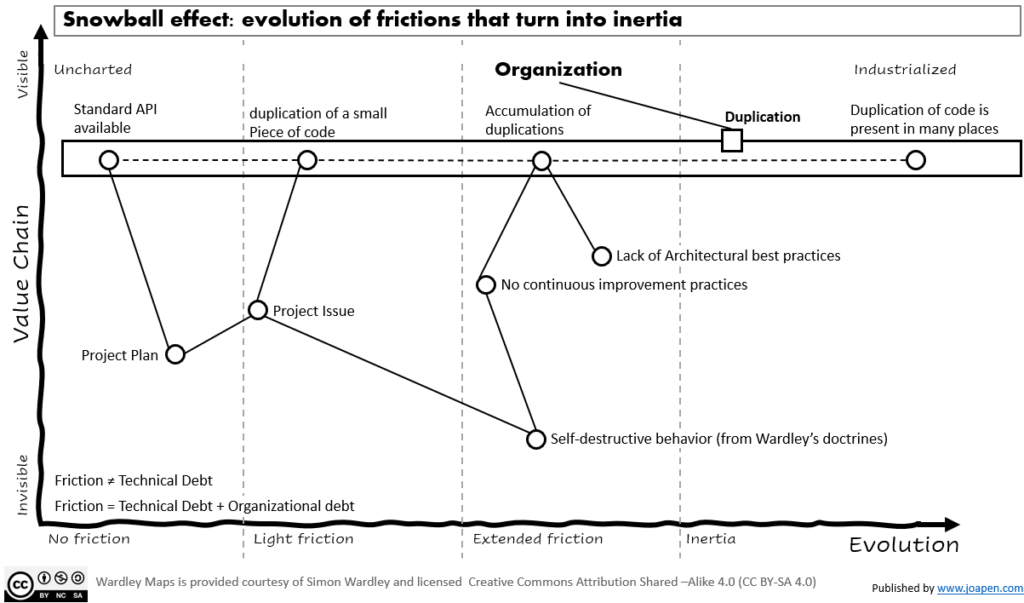Purpose of this article
I am going to theorize about a phenomenon, inertia. When theorizing I am going to leave many things behind, but this simplification often allows the listener to differentiate what is important from what is superfluous.
The context
Things rarely happened as planned, in a world where information is asymmetric and many unexpected things happen, you have to define a long term purpose, organize yourself with some main drivers and start executing.
During execution the reality vary and you will have to adjust. These variations provoke a gap between plan (strategy) and reality (execution) is what I call “friction”. The formal definition of “friction” is: the resistance that one surface or object encounters when moving over another.
This friction or resistance of the plan to move through reality can have so many forms and ways to appear.
First I would like to review different types of friction.
Short term and long term friction
Short term friction
Short term friction usually appears when a problem show up or an external factor influences our journey. The majority of operation leads work on this type of issues and focus their energies to solve them and stick to the plan (the strategy).
If we are able to handle these issues and there is not a big accumulation of friction then we will be able to continue working on our execution without major deviation from the plan.
We have to be aware that this short term friction sometimes leave some attrition on the organization.
Let’s be serious: friction is unavoidable, we have to deal with it.
Long term friction
When organizations are alive for years, there is an accumulation of friction that needs to be attended. It’s like my 14 years old car, there are so many pieces that have been there for a long time and they are attrited.
This accumulation of friction is very dangerous because it can provoke inertia (a tendency to do nothing or to remain unchanged).
And this inertia can provoke a deviation from the “moral imperative” (our purpose as organization).
Acceptable and unacceptable friction
Ideally there should not be “acceptable friction” but reality is that shit happens and we have to define our threshold about what is acceptable and what is not.
We are overloaded of short term goals that sometimes we lose the perspective of the long term run. This lack of perspective needs to be resolved so we are looking at the situation in a better way.
What is the origin of inertia?
So many people are able to identify inertia in an organization, but this is not useful at all, it’s late. We should focus on the origins of this inertia first.
I have not a recipe about how to do it, there are many ways to identify and look into the roots of the long term issues we have in our organizations.
Let’s start with the definition of inertia: “a tendency to do nothing or to remain unchanged“. I will expand this definition:
- To do nothing when something is done in a wrong way,
- or to remain unchanged when external forces change the context.
This moves me to these questions:
- Do we have mechanisms in our organization to minimize the things that are done wrongly?
- Are we aware of the external forces that change the context?
These two questions should be on the table of the leaders of the organization from time to time.
But what is the origin of inertia?
There are so many, but the main ones in my honest opinion are:
- Short term incentives are very aggressive and they let the long term incentives aside.
- There are no mechanism to increase the maturity of the things done.
- The organization does not look at the problems from the right perspective.
- The organization is not working with the right attitude or prevalent doctrines.
Ok, these causes could explain the origin of inertia, but they are not tangible things we could work on. So let’s come back to “frictions”.
Evolution of frictions that turn into inertia

This map shows:
- On the X-axis, the evolution that goes from “no friction” to “inertia”.
- You start accumulating small pieces of friction in the systems, processes and behaviors, these light frictions accumulate and extend through the organization, and suddenly, some years later you recognize the inertia.
- I have added a classic issue: duplication, on an software context; that is painted as a pipeline as it evolves from “no friction”, through “light friction, then “extended friction” and to “inertia”.
- Under the visible duplication there are so many reasons, and you have to be able to identify them.
- Self-destructive behavior is the first phase used by Simon Wardley to identify how organizations behave against themselves. This has been added to the map as it’s something relevant.
This map could perfectly be seen as an Ishikawa diagram (used typically under Six Sigma):

On this Ishikawa diagram there’s not only short term frictions, there are doctrines too. The impact of the wrong doctrines in an organization are so much times ignored, and this is part of the root cause too.
Summary
“If you want to eat an elephant, cut it in slides”, inertia is so many times the elephant in the room, and we should be able to concrete where it comes from.